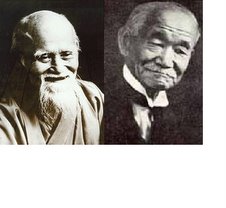Friday, February 2, 2007
Belts and Indications...
When I first began to learn about martial arts I thought whatever belt a person was wearing was an exact indication of their skill level. Later, I thought it was a rough indication of skill and more an indication of time of rank. I was discussing what it actually meant with Andy and he said it depends on the wearer. That mostly it's just something given to students to give them a sense of accomplishment. I just wonder if belt ranks cause more problems than benefits. Lots of people quit after getting their Shodan (which I personally see as a benefit). For those that don't though, I get the feeling they feel they don't deserve it. I know I didn't feel like I deserved my yellow, green, or brown belt when I was awarded it. My Sensei Pat assured me that it's normal and I'll never feel like I deserve them when I earn them because I'm looking at what I feel I ought to know instead of how much I've learned between each one. That works great except for the times I fell out of practicing for a few months at a time. You never dramatically feel your skills improving but you can defiantly tell when they've dropped. Belts don't degrade though, so you're left a green belt but you feel like a yellow or even white. I have no idea what brought this post up, and it has no questions...just some thoughts.
Subscribe to:
Post Comments (Atom)



2 comments:
It was my intention to convey that what the belt means depends on the wearer. I'm sure the things it symbolizes are as myrad as the people wearing it. I wondered if they were created to give a sense of accomplishment that people could work towards.
I view belt ranks as having several meanings - deveral of which y'all have touched upon.
1) it is a form of external motivation for the student. I'd rather have internally motivated students, but God made some folks very externally motivated and it seems He made everyone external to some degree.
2) it is a rough indicator of skill and time in the art. just like in academia, one earns a HS degree or a GED then an AA, then a BS, then a MS, then some form of Doctoral degree, then a post-doctoral certificate. These degrees are not perfect indicators of knowledge, but they are aggregates of knowledge, persistence, and time in the system.
3) Belts are pretty good indicators of which students should be grouped with which others and what page of the syllabus they should be working on. So, while the belt does not make the man, it serves a logistic purpose in class organization.
4) Belts are pretty good markers of who you should pay the most attention to in class.
In a valid ranking system there is cross-sectional improvement. this means that each successive rank is (on average) populated with more knowledgable and experienced people.
valid rank systems also show longitudinal improvement. this means that if you pick any individual and watch him move through the ranks he will obviously have more skill at each successive rank.
Besides academia, the military is another good example of a society in which ranks play a large role. Generally there is longitudinal and cross-sectional progression, but there are anomalies. Everyone has heard of the sergeant (or worse, the gunny) who runs the whole outfit while the West Point trained Lieutennant gives the appearance of being in control - but for the most part, the longer you stay in, the better your rank, and each successive rank is populated with more experienced people. In the military there are also anomalies created by field-promotions (called batsugan in judo) or differences in wartime rank and peacetime rank.
I think it would be interesting to study in some depth different subcultures that have rank systems (i.e. academia, military, scouts, police, martial arts) in order toe see what benefit they derive from having different ranks.
Post a Comment